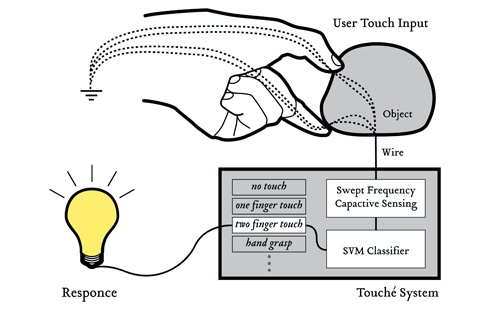Disney’s Apple and Disney are good buddies, so it will interesting to see if the former adopts, helps with or has any interaction with Disney’s new Touché technology.
According to Disney, Touché is a new sensing technology that proposes a novel Swept Frequency Capacitive Sensing technique that can not only detect a touch event, but simultaneously recognize complex configurations of the human hands and body during touch interaction. This enhances touch interaction in a broad range of applications, from enhancing conventional touchscreens to designing interaction scenarios for unique use contexts and materials.
For example, in Disney’s explorations, the company says it added complex touch and gesture sensitivity not only to computing devices and everyday objects, but also to the human body and liquids. The company says instrumenting objects and material with touch sensitivity is easy and straightforward. Purportedly, a single wire is sufficient to make objects and environments touch and gesture sensitive. You can see a video of Touché in action at http://www.disneyresearch.com/research/projects/hci_touche_drp.htm .
Touché uses a sensing circuit, which monitors changes in an electrical signal passing through an object when the object is touched by a conductive material. The technology recognizes the difference of touch by a single finger, two fingers, a grasping hand, and other gestures.
Touché can be used to recognize touch and gesture on everyday objects. It can recognize how the user is grasping a handheld device. Touché can recognize how the user touches his own body. It can even can recognize hand gestures on liquids.
The possibilities are endless. But, as far as Apple is concerned, the Disney video imagines a future where you interact with your smartphone (or, of course, an iPad or iPod touch) by performing touch gestures on your own body. For example, grasp your own hands to stop the music in iTunes music, tap on your palm with two fingers to go forward a track, ball one hand to pop up the local weather.
When it comes to the Mac, Touché could allow couches, doorknobs, clothing, and even water to sense your movement or finger swipes. If you can type on a desktop, the need for a dedicated keyboard may disappear — or, at least, diminish. Imagine Apple laptops and/or iMacs with optional keyboards that you would only use when using a Touché-enabled “virtual” keyboard was impractical.
— Dennis Sellers


